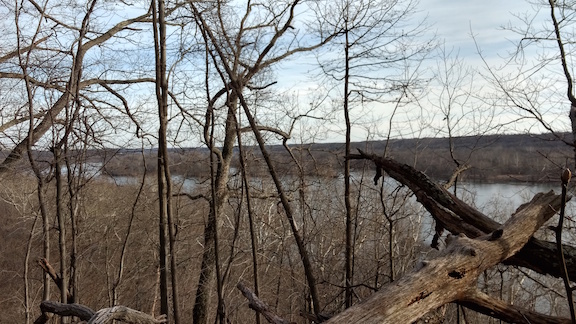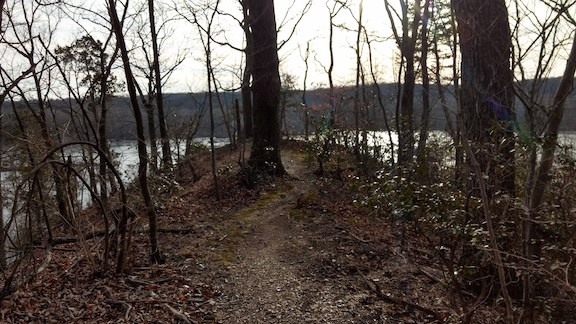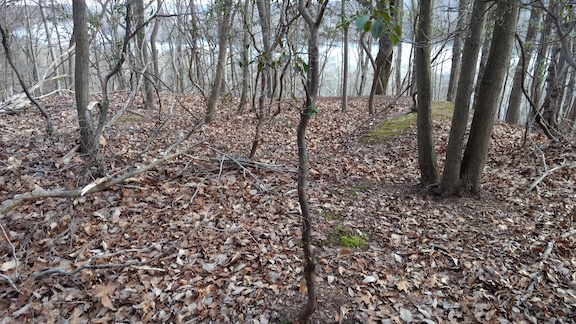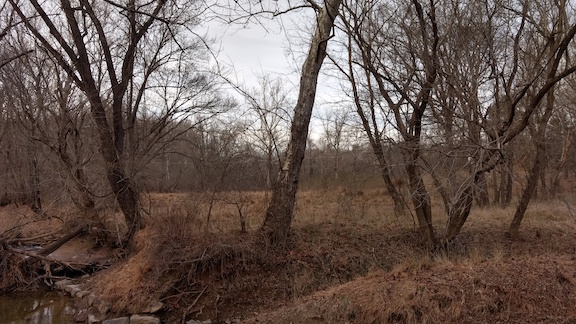A Quiet Corner of the War

I recently had the chance to spend some time in Montgomery County, Maryland, just east of Washington, DC. I’m usually driving through on my way somewhere, so have never explored the area’s history very much. This particular day I was on my way to a talk and book signing, and make time to get off the highways in search of local history.
I came across Blockhouse Point Conservation Park, a county-run park. While it includes several miles of hiking and horse trails, the park preserves, as the name suggests, the site of a Civil War blockhouse. I eagerly parked, consulted the maps at the trailhead, and headed into the woods.
As I hiked, I reflected on this lesser-known aspect of the war. The park’s brochure describes it well, “Long hours of picket duty and drill. Swampy camp conditions and muddy drinking water. Forays into Virginia chasing Confederate raiders.”
This is a part of the conflict we often gloss over, but it was the reality for much of the war for Union troops in any theater. While the headline events like savage battles, epic marches, and grand campaigns capture our attention, the truth is that the day to day reality for many Union troops was something dull and monotonous, and dangerous, like duty at the Potomac River blockhouses.
As the war dragged on and Federal armies penetrated deeper into the Confederacy, occupation and control of captured areas demanded more and more of the Union army’s attention. Union commanders had to deal with civil issues and act as a police force in regions like northern Virginia, middle Tennessee, central Missouri, and the Carolina coast.
Over time, the Union government had to adopt, and refine, policies regarding the conduct of the war, interactions with civilians, and procedures for occupying forces. These were issues that commanders had little experience with, and likely had never thought of in the heady, patriotic days of 1861.
Union forces arrived here that first year of the war to set up camp. From this isolated outpost, Union troops patrolled the Chesapeake and Ohio Canal, the Potomac River, and nearby roads. They drilled and performed routine camp duties. They interacted with unsympathetic civilians. They explored the hills and valleys in their leisure time. And they likely pondered the movements of the large armies that were making headlines, knowing full well that their trials and tribulations were not being captured for posterity.
Moreover, the blockhouse overlooking the Potomac and the C&O Canal was quite literally on the front lines, on the border, with Virginia just across the river. Forays into the Old Dominion would have been frequent, and dangerous. Guerilla activity, much of it led by Col. John S. Mosby, annoyed these occupying troops and disrupted their efforts to maintain the area’s security.
The Federals would have also had to interact with civilians, many of whom likely resented their presence. Dozens of local men had left to join Confederate forces and their wives and families remained. Men from New York and Massachusetts likely bought produce or other goods from these civilians, but also had to oversee their movements and monitor their activities. It was an uneasy peace between the civilians and the soldiers.
As I hiked up one final steep hill, my effort was rewarded with a spectacular view of the Potomac, and Virginia on the other side. I emerged at a point of land jutting out over the river. It had obvious military significance, I could see clearly to the east, west, and south. Below me ran the C&O Canal.

Walking further, I found the remains of the earthworks at the blockhouse site. While I was enjoying my walk on a day off from work, I remembered that the men stationed here were on guard duty twenty-four hours a day, seven days a week. In the rain, in the snow, in the cold, on Christmas Day, it didn’t matter: security was primary.


My boots sunk slightly into damp ground, and I had to step carefully over jagged rocks. I imagined the soldiers struggling in brogans over this terrain in search of firewood every day or refiling canteens from the nearby spring.


The park has interpretive signs that discuss not only Civil War history but other topics as well. Archaeological finds are also highlighted. Personal items from the blockhouse and campsites have shed light on life here during the war. I am sure that erosion, both natural and man-made, metal detecting, and relic hunting are all concerns for park managers.
Returning to my car, I reflected on these various topics that don’t often make it into our studies of the Civil War, both in the classroom or in the field. Issues of maintaining military discipline in isolated posts, of cooperating with local authorities, of interacting with hostile or indifferent civilians, of Union military policy, and of historic preservation all permeated my mind on the return trip.

Very interesting blog post. We seldom think of the units which did not have glorious service in the mobile armies, such as the units that were stationed here. However, these troops also dealt with bad water and sanitation, iffy supply, disease and danger. I would like to know how many months a particular unit might have been detailed to this duty, and which regiments they were. Thanks for sharing.
Thanks for your comments. A lot of units came and went over the years here, so it gets complicated quickly. Briefly, 5,000 Union troops were stationed in the area in the fall of 1861. They were the division led by Gen. Alpheus Williams, and included:
5 CT
10 ME
28 NY
46 PA
2 MA (with Robert Gould Shaw, later commander of the 54th MA)
27 IN
3 WI
Later on the 2nd MA Cavalry was there. Other units passed through too. It would take a big more digging to identify which units were here and track their exact lengths of stay.
Thanks for your reply. I has expected that units would have been rotated, based upon the needs of the service at any given time. Several of these units went on to see significant action at Cedar Mountain, Antietam, Gettysburg and others. I wonder if they looked back upon this earlier duty with fondness after seeing hard service later on.
I agree with the above reader… It’s great to learn more about what soldiers who were not marching or fighting were up to, and to imagine what their lives must have been like day to day. The interactions between federal troops and the citizens of Maryland that Mr. Dunkerly refers to are especially interesting to me. From what I’ve read, they varied, from contentious to strained-but-cordial to friendly. Seventeen-year-old Luther Ladd, one of the first (some have claimed the first) of Union soldiers killed-in-action after Ft. Sumter was fired upon, fell in a riotous protest of Maryland citizens as his Massachusetts volunteer unit marched though Baltimore on April 19, 1861. Yet I’ve read excerpts from the letters from Union soldiers who passed through or were camped in Maryland that heap praise on the state’s civilians for their friendly support, which some Gettysburg veterans claimed was more forthcoming in Maryland than Pennsylvania. I wonder if there is any documentation in letters or diaries about the civilian-soldier interactions around the Blockhouse?
I appreciate your observations, Rob. This is something I haven’t looked into but it surely be insightful. We certainly could read through letters, diaries, and reports from those who were here, and compare that to similar documentation from units marching to Gettysburg. As there were probably close to twenty regiments or parts of regiments here over the course of the war, that would be quite time consuming, but a worthwhile study!
Thanks for your reply Bert. I actually wasn’t thinking in terms of a comprehensive search for documentation about civilian military-civilian interactions and relations around Blockhouse Point. That would be time consuming indeed! My point is that even just one or two facts or soldiers’ stories about those kinds of interactions, the commerce between troops and the surrounding civilian population, and the other aspects of life on the kind of backwater outpost you described in your piece can be interesting stuff. Stuff that I might easily overlook. Which is one reason why I appreciated your piece, and why I appreciate the ECW blog.
Thanks so much, Rob. I’m sure there are a few primary sources that could shed light on this topic. I get the sense that most of the local population was pro-Confederate, while in other parts of Maryland to the west and north they were pro-Union.
Roger that. Thanks.